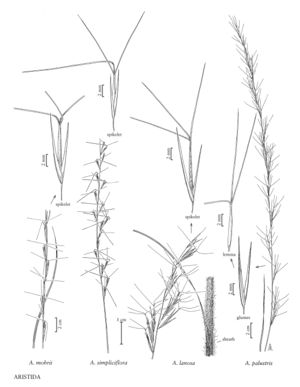Difference between revisions of "Aristida lanosa"
FNA>Volume Importer |
FNA>Volume Importer |
||
| Line 17: | Line 17: | ||
-->{{Treatment/Body | -->{{Treatment/Body | ||
|distribution=Md.;N.J.;Okla.;Miss.;Tex.;La.;W.Va.;Mo.;Del.;Ala.;Tenn.;N.C.;S.C.;Va.;Ark.;Ill.;Ga.;Fla. | |distribution=Md.;N.J.;Okla.;Miss.;Tex.;La.;W.Va.;Mo.;Del.;Ala.;Tenn.;N.C.;S.C.;Va.;Ark.;Ill.;Ga.;Fla. | ||
| − | |discussion=<p | + | |discussion=<p>Aristida lanosa is restricted to the eastern United States, where it grows in dry fields, pine-oak woods, and uplands, chiefly in sandy soil. It is sometimes confused with A. palustris, but differs in several reproductive, vegetative, and habitat characteristics.</p> |
|tables= | |tables= | ||
|references= | |references= | ||
| Line 33: | Line 33: | ||
|basionyms= | |basionyms= | ||
|family=Poaceae | |family=Poaceae | ||
| + | |illustrator=Linda A. Vorobik and Andy Sudkamp | ||
|distribution=Md.;N.J.;Okla.;Miss.;Tex.;La.;W.Va.;Mo.;Del.;Ala.;Tenn.;N.C.;S.C.;Va.;Ark.;Ill.;Ga.;Fla. | |distribution=Md.;N.J.;Okla.;Miss.;Tex.;La.;W.Va.;Mo.;Del.;Ala.;Tenn.;N.C.;S.C.;Va.;Ark.;Ill.;Ga.;Fla. | ||
|reference=None | |reference=None | ||
| Line 38: | Line 39: | ||
|publication year= | |publication year= | ||
|special status= | |special status= | ||
| − | |source xml=https:// | + | |source xml=https://bibilujan@bitbucket.org/aafc-mbb/fna-data-curation.git/src/314eb390f968962f596ae85f506b4b3db8683b1b/coarse_grained_fna_xml/V25/V25_1024.xml |
|subfamily=Poaceae subfam. Aristidoideae | |subfamily=Poaceae subfam. Aristidoideae | ||
|tribe=Poaceae tribe Aristideae | |tribe=Poaceae tribe Aristideae | ||
Revision as of 17:13, 30 October 2019
Plants perennial; loosely cespitose. Culms 65-150 cm, sometimes thickened at the base, erect, unbranched; internodes glabrous; nodes concealed. Leaves cauline; sheaths longer than the internodes, usually lanose-floccose, occasionally glabrate; ligules about 0.1 mm; blades 10-25(30) cm long, 2-6 mm wide, flat, light green or slightly blue-green, glabrous abaxially. Inflorescences paniculate, (25)35-70(82) cm long, (2)3-8(10) cm wide; rachis nodes lanose-floccose; primary branches 3-12 cm, appressed at the base, without axillary pulvini, ascending to spreading distally, sometimes loose and somewhat flexible, with 4-12 spikelets per branch. Glumes usually unequal, 1-veined, brownish-green to dark brown or purplish; lower glumes 8.7-18 mm, with a keeled mid-vein; upper glumes 8.4-15 mm, awn-tipped, awns to 3 mm; calluses 0.5-1 mm; lemmas 6.5-10 mm, smooth to scabridulous, mostly dark purplish-mottled, slightly narrowed distally but not beaked, junction with the awns not evident; central awns 12-28 mm, curved at the base, often strongly so; lateral awns 7-17 mm, at least Yi as long as the central awns; anthers 3, about 3 mm, brown. Caryopses 5-6 mm, chestnut brown. 2n = unknown.
Distribution
Md., N.J., Okla., Miss., Tex., La., W.Va., Mo., Del., Ala., Tenn., N.C., S.C., Va., Ark., Ill., Ga., Fla.
Discussion
Aristida lanosa is restricted to the eastern United States, where it grows in dry fields, pine-oak woods, and uplands, chiefly in sandy soil. It is sometimes confused with A. palustris, but differs in several reproductive, vegetative, and habitat characteristics.
Selected References
None.
